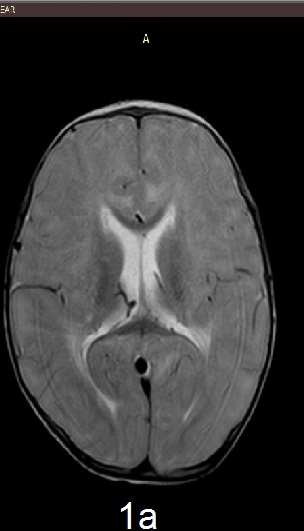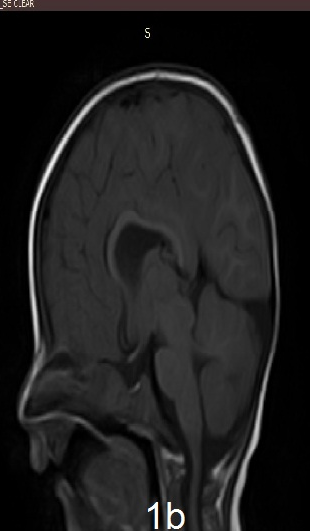Bharat Kansal, AC Basavaraj, Madhu S Pujar, Suhas BS, N Leenatha Reddy.
Department of Pediatrics, Bapuji Child Health Institute & Research Center, JJMMC, Davangere, India.
ADDRESS FOR CORRESPONDENCE
Bharat Kansal, Department of Pediatrics, Bapuji Child Health Institute & Research Center, JJMMC, Davangere – 577004, India.
Email: bharat100989@gmail.com | | Keywords | | Pelizaeus-Merzbacher Disease, nystagmus, hypotonia, megalocornea, proteo lipid protein 1 | | | A 13 months old boy born of non-consanguineous marriage presented with global developmental delay and failure to thrive with weight, height and head circumference were less than 3rd standard deviation as per World Health Organization (WHO) charts. He was born full term by caesarean section, cried after 5 minutes of birth after resuscitation and was kept in neonatal intensive care unit NICU for 8 days for post resuscitation care. There was no convulsion during the neonatal period. Birth weight was 2800 grams. There was a history of spontaneous abortion at 10 weeks of gestation in first pregnancy. At 2 months, abnormal eye movements with nystagmus having vertical, horizontal and rotatory component were noted. However parents did not show the child to any doctor hoping that the child will improve on his own. On presentation to us, he had head lag, generalized hypotonia, hypertelorism, undescended testis, costochondral beading, microcephaly and hepatosplenomegaly. Ophthalmologic evaluation showed bilateral abnormal eye movements with horizontal, vertical and rotatory nystagmus, megalocornea right side with horizontal corneal diameter of 13.5mm and bilateral cataract. MRI brain showed bilateral periventricular white matter hyperintensities in posterior parieto-occipital regions on T2 weighted axial section. T1 weighted sagittal section showed turricephaly. Genetic study was not done as it is not available in India.
Figure 1a- T2 weighted axial section shows bilateral periventricular white matter hyperintensities in posterior parieto-occipital regions

Figure 1b- T1 weighted sagittal section showing tower like head (turricephaly)

Pelizaeus-Merzbacher disease (PMD) is a rare x-linked disorder of proteo lipo protein (PLP) expression, first described clinically in 1885. This disease is a hypomyelinating leukoencephalopathy which is slowly progressive and leads to nystagmus, head nodding, hypotonia, motor and intellectual disabilities with hypomyelination of brain. This disease results from point mutations that result in amino acid substitutions or complete deletion/duplication of the PLP 1 gene. These gene products play a major role in the development of oligodendrocytes for myelination. (1) The PLP gene is linked to chromosome Xq21-22 region. (2) Brain MRI images in PMD typically demonstrate a pattern of hypomyelination with a reversal or discordance of white matter signal intensity on T2 weighted images. T1 weighted images demonstrate normal or isointense white matter. (3) Inheritance of megalocornea is usually X-linked recessive which maps to chromosome Xq21.3-q22. (4) Nowhere association between PMD and megalocornea is documented. There is no definitive treatment for PMD Only supportive therapy from a team that includes specialists in neurology, physical medicine, orthopedics, pulmonary medicine, and gastroenterology is recommended for the condition. Typically, the progression of the disease slows towards the middle or end of the first decade, with death occurring in the early adult ages. (1-4)
| | | | Contributor Statement | | All authors were involved in management of this patient. BK drafted the manuscript which was approved by all authors. | | | | Compliance with Ethical Standards | | Funding None | | | | Conflict of Interest None | | |
- Nave KA, Boespflug-Tanguy O. X-linked developmental defects of myelination: from mouse mutants to human genetic disease. Neuroscientist 1996;2:33-43. [CrossRef]
- Mattei MG, Alliel PM, Dautigny A, Passage E, Pham-Dinh D, Mattei JF et al. The gene encoding for the major brain PLP maps to the q- 22 band of the human X chromosome. Hum Genet. 1986;72(4):352-3. [CrossRef]
- Kibe T, Miyahara J, Yokochi K, Iwaki A. A novel PLP mutation in a Japanese patient with mild Pelizaeus-Merzbacher disease. Brain Dev 2009; 31(3):248-51. [CrossRef]
- Chen JD, Mackey D, Fuller H, Serravalle S, Olsson J, Denton MJ. X-linked megalocornea: close linkage to DXS87 and DXS94. Hum Genet 1989 Oct;83(3):292-4. [CrossRef]
DOI: https://doi.org/10.7199/ped.oncall.2015.47
|
| Cite this article as: | | Kansal B, Basavaraj A, Pujar M S, BS S, Reddy N L. Co-existence of Pelizaeus-Merzbacher Disease and Megalocornea. Pediatr Oncall J. 2015;12: 86-87. doi: 10.7199/ped.oncall.2015.47 |
|